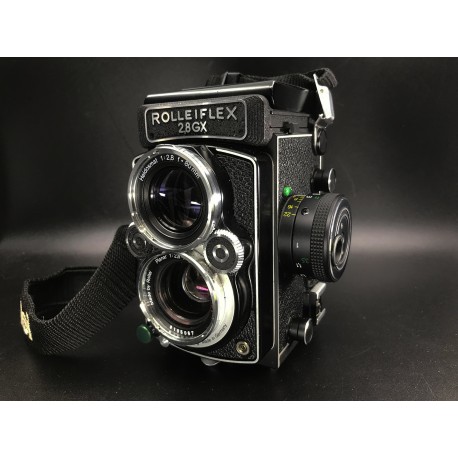
Characteristic is the pothole with movable lenses for diotric correction present only in this model and in 2.8 C. I also want to mention when I put everything back together I noticed that a tiny pin fell out and I believe it's for the double exposure dial so that's not working but so far the advance is acting normal, so maybe it was a double exposure problem to begin with. a rather rare car produced in around 20000 copies in 1953. Now I am thinking it's either the scratches on the taking lens causing it, which doesn't appear to be bad enough or the front element is a mismatch.

I did a quick check on the focus by placing a small ground glass on the film plane and set up a target at 3 feet and checked the focus and it looked ok. I don't think anything I did is going to correct the blurred imaged but maybe I will get lucky. After several times I seem to have the film advance problem straightened out so I put another roll in for testing. Before going straight onto developing the TLR system, they would make stereo cameras- a system which used two identical lenses to take two identical photos. It all pointed to a cleaning so I took the side off and using an electronic cleaner sprayed all the linkages and then oiled them with a sewing machine oil. Film Transportation: winding lever with auto stop, no red window, film pressure plate without color coating. Film: 6圆: B II 8 (120) & 35mm with Rolleikin I adapter set. Proper adjustment to focal length can be effected easily in the case at earlier Rolleiflex Cameras (whose knobs are not the right size to permit use of the adjustment plate) by means of the ground glass screen image. Shutter: Compur - Rapid, 1 - 1/500 sec., T & B, self timer. when I developed the pictures all were blurred and some were double exposed which I assumed it was the film advance problem or a problem with the double exposure mechanism. lens) the Rolleimeter 2.8 is supplied together with suitable adjustment plate. So she said, Wait here, while she ran back to the house to get her father's Rolleiflex 2.8D, to take his picture. When I put a fresh roll to test for picture quality with the HP 5 it would sometimes bind up and not advance and I also noticed after a few pictures the counter didn't advance. To all of you, thank you very much Thanks. Charles Lin gave permission to use his photo of a Rolleiflex 2.8 FX. Sometimes it would be 9 o'clock sometimes 8 and sometimes it just kept rotating, but it all advanced to 12 as normal. Karl Keung gracefully provided me with a number of photographs of his unique mint 2.8 E still having the original factory seals. A perfect digital camera for me would be a rolleiflex with a 36mp 6圆 sensor, no need for a screen even. I love it and craved a 2,8 Xenotar more than a Leica in the day Made plenty of great b&w prints from it. I ran a few well outdated film through just to check the mechanics and I noticed that when you advanced the film to cock the shutter it stopped in a different position on the clockwise stroke. The Rolleiflex is a perfect camera for methodical photography as it slows you down. I also noticed a film advance problem that I only seemed to happen with HP5 plus. I was told it had 3 problems, slow shutter which I don't see, fungus on lenses but it's more cleaning scratches than fungus and the meter didn't work which I was ok with. Since the two lenses are of identical focal length (f 80 mm, picture angle Across diagonal, 53) it follows that the image in both sections of the camera will. It was an as is purchase but with a 30 day return. Schneider Xenotar4 Rolleiflex 2.8FRolleiflex 2.I picked up one that I new needed repair but didn't know about the blurred images.
#ROLLEIFLEX 2.8 PICTURES SERIES#
Thanks!!! based on the info you gave me this is what is coming upĢ,400,0002,442,1331960-1966Rolleiflex 2,8 F With film lengths of up to 36 exposures, 24 x 36 mm, the 35 mm film is well suited, because of its lower cost, for longer picture series of technical. The 2,8 was $400 to $500 more at the time, used. PS to give you an idea on price, I paid $400 in 1982 for my 3,5 E, used. Rollei folks are as bad as Leica folks when it comes to glass Planar gets a better price because it's a Zeiss Planar. A 1969 camera will usually cost more than a 1954 camera, and a 2.8 model will typically cost more than the same era 3.5 model, etc. About once a year you need to exercise the shutter, fire it thru all speeds a couple of times. The cost of a Rolleiflex can vary drastically, but in a general sense the newer the camera and the better the features, the more it will cost.

.jpg)
My 1950's 3,5 E shoots as good as it did new. There are new old stock ones around and they will break $5000 mark. The 'F' started around 1960.Ī KEH price isn't too high, depends on year and condition. Type in your number and a year will pop up.
#ROLLEIFLEX 2.8 PICTURES SERIAL NUMBER#
Do a search for Rollei serial number index.


 0 kommentar(er)
0 kommentar(er)
